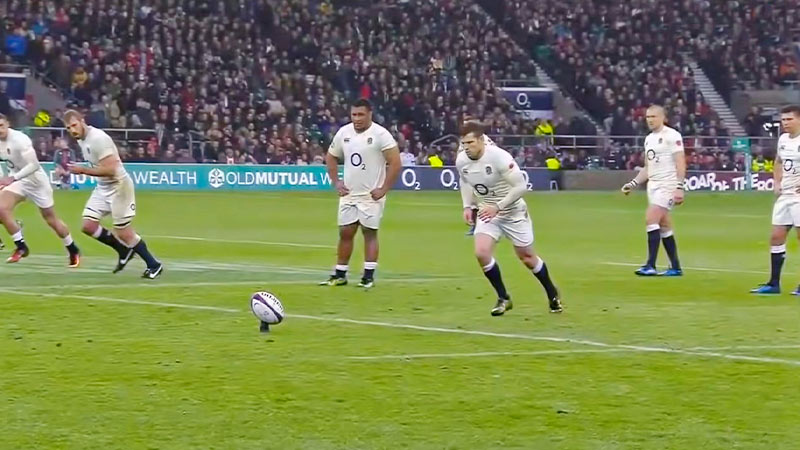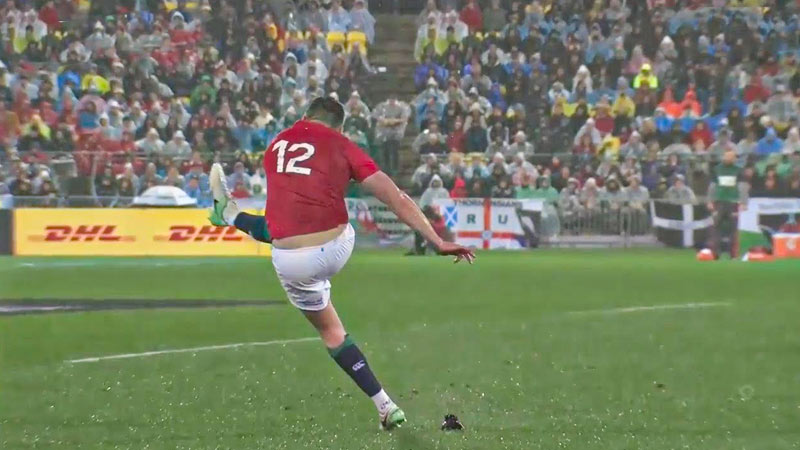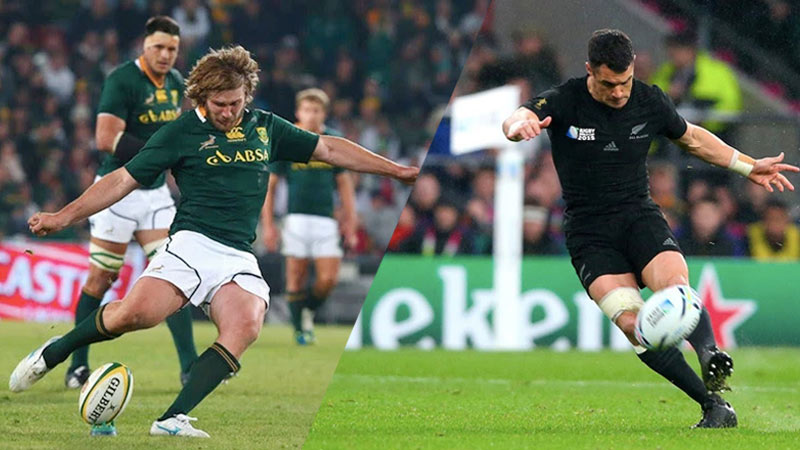A squib kick in rugby is a specialized kicking technique employed during restarts, such as kick-offs or drop-outs, to strategically disrupt the opposing team’s ability to cleanly receive the ball and gain field position.
Unlike traditional high kicks, a squib kick is intentionally executed with a low trajectory, hugging the ground and causing the ball to bounce unpredictably.
This unpredictability makes it challenging for the receiving team to cleanly field the ball, often resulting in turnovers or advantageous field position for the kicking team.
The use of squib kicks showcases a team’s tactical acumen, seeking to gain a competitive edge by keeping their opponents off-balance and potentially regaining possession of the ball.
The Definition of a Squib Kick in Rugby
A squib kick in rugby is a tactical kicking technique used primarily during restarts, such as kick-offs or drop-outs, to gain field position and disrupt the opposition’s ability to counterattack effectively.
It is a valuable tool in a team’s arsenal, allowing them to control the flow of the game and potentially regain possession of the ball.
Squib kicks are often employed strategically when a team wishes to avoid giving their opponents a clean, high-hanging kick-off that can be easily caught and returned.
Here’s a breakdown of what a squib kick in rugby entails:
Low Trajectory
Unlike a traditional rugby kick-off that aims for a high and deep kick to reach a specific target area, a squib kick is designed to travel with a low trajectory, typically just above the ground.
This low trajectory makes it difficult for the receiving team to catch the ball and often results in the ball bouncing unpredictably.
Bouncing Ball
The key feature of a squib kick is the intentional bounce of the ball. By making the ball bounce erratically along the ground, it becomes challenging for the opposition to cleanly field the kick.
This unpredictability can lead to mistakes, fumbles, or turnovers, giving the kicking team an opportunity to regain possession.
Directional Control
Squib kicks can also be aimed in a specific direction, either toward a sideline to limit the receiving player’s options or toward a particular area of the field where the kicking team has a better chance of recovering the ball.
Speed and Power
A well-executed squib kick should have enough speed and power to travel a significant distance along the ground while remaining low. This makes it difficult for the opposition to reach the ball before it bounces.
Strategy
Squib kicks are often employed strategically when a team is concerned about the abilities of the opposition’s returners, especially if they have a strong kick return game.
By utilizing a squib kick, the kicking team aims to disrupt the opposition’s plans, create confusion, and ideally recover the ball themselves.
Risks
While squib kicks can be effective, they also carry some risks. If not executed properly, they can result in the receiving team gaining excellent field position or even breaking through for a big return.
Therefore, it’s essential for the kicker to have good control and precision when employing this tactic.
When to Do a Squib Kick?

A squib kick in rugby can be employed strategically in various situations, depending on the game’s context and your team’s objectives.
Here are some scenarios when it might be a good idea to execute a squib kick:
Kickoff or Restart Tactics
Squib kicks are commonly used during kickoffs or restarts. You might consider a squib kick when you want to prevent the receiving team’s dangerous returner from gaining significant yardage or when you want to disrupt their return set up.
Late in the Game
If your team is trying to manage the clock and protect a lead in the closing moments of a game, a squib kick can be used to eat up valuable seconds. It forces the receiving team to spend more time handling the bouncing ball and setting up a return.
Field Position
When your team is backed up near its own try line, and you want to ensure that the opposing team starts their attack from a less favorable field position, a well-executed squib kick can be effective.
Surprise Element
Squib kicks can catch the opposition off guard when used sparingly and unpredictably. Employing a squib kick when the receiving team expects a deep kickoff can disrupt their game plan.
Against Strong Returners
If the opposing team has a particularly skilled return specialist who poses a significant threat, a squib kick can be used to limit their impact by making it harder for them to field the ball cleanly and set up a return.
Recovering Possession
In some situations, especially when you need to regain possession quickly, a squib kick can be executed with the hope of creating a fumble or recovering the ball immediately after the kick.
Wind and Weather Conditions
Weather conditions, such as strong winds, rain, or muddy field conditions, can make handling a squib kick more challenging for the receiving team. These conditions may increase the effectiveness of a squib kick.
Advantages of a Squib Kick in Rugby

The squib kick is a strategic maneuver in football, particularly on kickoffs, with several potential benefits for the kicking team.
Here they are:
Field Position
One of the primary advantages of a squib kick is its ability to limit the opposing team’s field position. Instead of kicking the ball deep, a squib kick travels along the ground, making it harder for the returner to gain significant yardage.
This can result in the receiving team starting their offensive drive from a less advantageous position on the field.
Reduced Return Yardage
Squib kicks are designed to minimize the chances of a long return. Since the ball is bouncing along the ground, returners often have to field it on the run or deal with unpredictable bounces, making it more challenging to set up a solid return.
Less Time for Returns
A squib kick typically reaches the return team more quickly than a high, deep kickoff. This reduces the time returners have to make decisions, set up blocks, and find gaps in the coverage, potentially leading to shorter return distances.
Increased Chance of Turnovers
The bouncing and unpredictable nature of the squib kick can lead to fumbles or muffed catches by the receiving team. This increases the chances of the kicking team recovering the ball and gaining an immediate advantage in field position or even regaining possession.
Disrupting Return Plans
Squib kicks can disrupt the return team’s well-laid plans for blocking and setting up return lanes. It forces returners and blockers to adjust on the fly, increasing the likelihood of coverage breakdowns and missed assignments.
Strategic Element
Coaches may use squib kicks strategically, particularly when they want to avoid kicking to a dangerous return specialist on the opposing team. This tactic aims to neutralize the impact of a skilled returner.
Time Management
In late-game situations where the clock is a factor, a squib kick can be used to eat up valuable seconds.
It forces the return team to use more time to field and return the ball, potentially reducing the time available for a game-winning drive.
How Opposing Team Can Counteract a Squib Kick?

Teams that face a squib kick can take several countermeasures to mitigate its effectiveness and potentially turn it to their advantage:
Designated Returner
Assign a player with sure hands and good field awareness as the designated returner. This player’s primary responsibility is to field the squib kick cleanly and secure possession. Having a reliable returner can prevent fumbles or mishandling of the ball.
Front-Line Blocking
Employ strong blocking schemes at the front line of the return team to protect the designated returner. These blockers can create a buffer zone, allowing the returner to field the squib kick without immediate pressure from the kicking team.
Angle of Approach
Train returners to approach the squib kick from an angle rather than head-on. This can help them better anticipate the bounce and adjust to the ball’s trajectory, reducing the chances of an awkward bounce or a missed fielding opportunity.
Secure Possession
Emphasize to returners the importance of securing possession first. In some cases, it may be advisable to fall on the ball rather than attempting an immediate return. Possession is paramount, and any yardage gained afterward is a bonus.
Quick Reaction
Encourage returners to react quickly and decisively to the squib kick. Waiting for the ball to come to them can allow the kicking team’s coverage to close in, making it more challenging to find running lanes.
Blocking Assignments
Ensure that blocking assignments for the return team are well-coordinated and executed. Even on squib kicks, returners may have opportunities for decent returns if blockers create lanes and maintain their assignments.
Practice
Regularly practice handling squib kicks during training sessions. This helps returners and blockers become more comfortable with the technique and timing required to handle these kicks effectively.
Adjustment in Coverage
On the kicking team’s side, if the receiving team consistently counters squib kicks effectively, they may need to adjust their coverage strategy. This could involve varying the kick placement, trajectory, or timing to keep the return team guessing.
Field Position Awareness
Returners should be aware of the field position and game situation. In some instances, it may be more advantageous to take a touchback (letting the ball go out of bounds in the end zone) rather than attempting a return.
Communication
Effective communication among returners and blockers is essential. Returners should be vocal in calling for the ball to prevent collisions or confusion, while blockers need to communicate to maintain their assignments.
Squib Kicks in Rugby History

Squib kicks, similar to those used in American football, are not a common tactic in rugby. Rugby has its own distinct set of kicking strategies and techniques.
While the sport does involve various types of kicks, they typically differ from the squib kick used in American football.
However, there have been instances in rugby history where unconventional or surprise kicks have been used to create advantageous situations or confusion on the field.
These instances may bear some resemblance to squib kicks in American football:
Grubber Kick
In rugby, the grubber kick is a low, bouncing kick along the ground, somewhat resembling a squib kick. Players use it to keep the ball low and difficult to field, making it challenging for the opposing team to control or counterattack.
The grubber kick is commonly used as a tactical tool to gain territory or put pressure on the opposition.
Chips and Cross-Kicks
These are variations of rugby kicks that involve lifting the ball into the air but with different intentions. A chip kick is a short, high kick that goes just over the opposition’s defensive line, with the goal of regathering the ball or creating a contestable situation.
A cross-kick is a diagonal kick toward the wings to find open space or an unmarked player.
Onside Kicks
While not common in rugby, there have been instances where teams have attempted onside kicks, similar to the surprise onside kicks seen in American football.
These kicks aim to regain possession immediately after a score by kicking the ball in such a way that it bounces off an opponent and back into the kicking team’s hands.
Drop Goals
Although not a squib kick per se, drop goals involve a quick and low kick over the crossbar, usually attempted within the field of play during open play. Drop goals can catch the opposition off guard and result in valuable points.
FAQS
Is a squib kick ever used as a tactical strategy in rugby sevens, or is it more common in traditional 15-a-side rugby?
Squib kicks can be employed in both rugby sevens and traditional 15-a-side rugby, but their usage may vary based on the game format and specific match circumstances.
Can a squib kick in rugby lead to a “knock-on,” where the ball is dropped forward and results in a scrum for the opposing team?
Yes, a squib kick in rugby can result in a “knock-on” if the receiving player fails to cleanly field the bouncing ball, causing it to go forward off their hands.
Are there any restrictions on the angle at which a squib kick must be executed in rugby, or can it be directed anywhere on the field?
There are no specific restrictions on the angle of a squib kick in rugby. It can be directed in any direction the kicker chooses, as long as it remains within the boundaries of the field of play.
Do rugby teams have designated players for executing squib kicks?
In rugby, any player can attempt a squib kick, as there are no specific restrictions on who can execute a kick during open play.
Can a squib kick be used as an offensive tactic in rugby?
While squib kicks are often used defensively to disrupt the opposition’s attack and field position, they can also be used strategically on offense.
Last Words
A squib kick in rugby is a less common but strategically valuable kicking technique that diverges from the conventional high, deep kicks used during restarts.
While not as prevalent as in American football, squib kicks in rugby involve low, bouncing kicks along the ground to disrupt the opposing team’s ability to cleanly field the ball and gain an advantageous field position.
This tactical maneuver showcases the sport’s flexibility, offering teams a means to control the flow of the game, limit the effectiveness of returners, and potentially regain possession.
Though not a core aspect of rugby’s kicking repertoire, the squib kick highlights the sport’s nuanced approach to strategy and field management.







